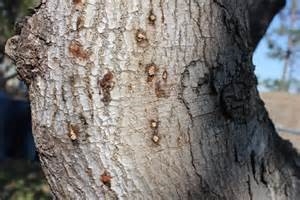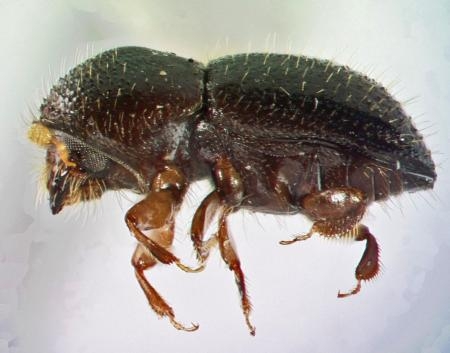FUSARIUM DIEBACK AND POLYPHAGOUS SHOT HOLE BORER ON AVOCADO
Akif Eskalen1, Richard Stouthamer2
1Department of Plant Pathology and Microbiology, UC Riverside
2Department of Entomology, UC Riverside
BACKROUND
Polyphagous shot hole borer (PSHB), Euwallacea sp. (#1) (Fig.1) is an invasive beetle that carries three fungal symbionts in a special structure in their mouth called a mycangium. These symbiotic fungi are Fusarium euwallaceae, Graphium euwallaceae and Acremonium pembeum (Freeman et al. 2013, Lynch et al. 2015). The adult female tunnels galleries into a wide variety of host trees, where it lays its eggs and grows the fungi (Fig.2, 3). The fungi cause the Fusarium Dieback (FD) disease, which interrupts the transport of water and nutrients in over 38 tree species that are suitable for beetle reproduction. A separate invasion was recently detected in San Diego county and is now being called Kuroshio shot hole borer (KSHB) and is another closely related species to PSHB (Euwallacea sp. (#5)) carrying two new fungal species - Fusarium and Graphium. Both species have been found causing damage on avocado in the los Angeles basin and San Diego County.
BEETLE BIOLOGY
Adult females of PSHB and KSHB (Fig. 1) are black in color and 1.8-2.5 mm long. Adult males (Fig. 4 ) are brown and smaller than females at 1.5 mm long. More females are produced than males, which are flightless and very rarely leave the galleries. Mature siblings mate with each other so that females are already pregnant when they leave to start their own galleries. Males do not fly, but stay in the host tree.
SYMPTOM AND SIGNS
External Symptoms: Attack symptoms, a host tree's visible response to stress, vary among host species. Staining (Fig. 5), sugary exudate ( also called a sugar volcano) (Fig. 6-7), gumming (Fig.8), and/or frass (Fig. 9) may be noticeable before seeing the tiny beetles. Beneath or near these symptoms, you may also see the beetle's entry/exit holes, which are ~0.85 mm in diameter Fig 10). The abdomen of the female beetle can sometimes be seen sticking out of the hole. Advanced fungal infections will eventually lead to branch dieback, as seen on this Avocado (Fig. 11).
Internal Symptoms: Fungal species associated with the beetle PSHB and KSHB cause brown to black discoloration in infected wood. Discolored wood can easily be seen when bark is scraped away around the entry/exit hole (Fig 10). Cross-sections of cut branches (Fig. 12) show the extent of infection.
KNOWN REPRODUCTIVE HOSTS OF PSHB and KSHB
PSHB attacks hundreds of tree species, but it can only successfully lay its eggs and/or grow the fungi in certain hosts.
Known Suitable Reproductive Host Trees of PSHB:
- Avocado (Persea americana)
- Box elder (Acer negundo)
- California Sycamore (Platanus racemosa)
- Big leaf maple (Acer macrophyllum)
- Evergreen Maple (Acer paxii)
- Trident maple (Acer buergerianum)
- Japanese maple (Acer palmatum)
- Castor bean (Ricinus communis)
- Mexican sycamore (Platanus mexicana)
- Red Willow (Salix laevigata)
- Mimosa (Albizia julibrissin)
- English Oak (Quercus robur)
- Coast live oak (Quercus agrifolia)
- London plane (Platanus x acerifolia)
- Cottonwood (Populus fremontii)
- Black cottonwood (Populus trichocarpa)
- White Alder (Alnus rhambifolia)
- Titoki (Alectryon excelsus)
- Engelmann Oak (Quercus engelmannii)
- Cork Oak (Quercus suber)
- Valley oak (Quercus lobata)
- Coral tree (Erythrina corallodendon)
- Blue palo verde (Cercidium floridum)
- Palo verde (Parkinsonia aculeata)
- Moreton Bay Chestnut (Castanospermum australe)
- Brea (Cercidium sonorae)
- Mesquite (Prosopis articulata)
- Weeping willow (Salix babylonica)
- Chinese holly (Ilex cornuta)
- Camelia (Camellia semiserrata)
- Acacia (Acacia spp.)
- Liquidambar (Liquidambar styraciflua)
- Red Flowering Gum (Eucalyptus ficifolia)
- Japanese wisteria (Wisteria floribunda)
- Goodding's black willow (Salix gooddingii)
- Tree of heaven (Alianthus altissima)
- Kurrajong (Brachychiton populneus)
- Black mission fig (Ficus carica)
Known Suitable Reproductive Host Trees of KSHB:
- Avocado (Persea americana)
- California Sycamore (Platanus racemosa)
- Big leaf maple (Acer macrophyllum)
- Coast live oak (Quercus agrifolia)
- Cork oak (Quercus suber)
- Coral tree (Erythrina humeana)
COMMENTS OF THE PEST AND DISEASE COMPLEX
Fusarium dieback (FD) is a new, invasive, beetle-vectored disease that has caused damage on avocado and other host trees in urban forests and wild lands in the Los Angeles basin since early 2012, and Orange and San Diego County since early 2013. This pest/disease complex has also impacted the avocado growing regions of Israel since 2009. DNA analyses of polyphagous shot hole borer (PSHB) beetles indicate that those from San Diego County are different from those in Los Angeles.and these beetles are now being called Kuroshio shot hole borer (KSHB) and are genetically similar to a beetle population in Taiwan. The beetles from Israel and the Los Angeles basin are genetically similar to those from Vietnam (Stouthamer unpublished data). Other studies have shown that species of Euwallacea, as well as thefusariumfungi they cultivate, are genetically distinct, including those from the Los Angeles basin (which are identical to those in Israel) and San Diego (O'Donnell 2014). These results indicate that at least two introductions into California have occurred. Each beetle carries its own novel pathogenic fungal species of Fusarium and Graphium, while the beetle from Los Angeles additionally carries a species of Acremonium (Lynch et al. in press).
Rapid spread of the beetle/fungi throughout various land use areas is attributed to the diverse range and quantity of suitable hosts in Southern California (Eskalen et al., 2013). Establishment of the beetle is a source of concern for the avocado industry, of which 90% of the United States crop is produced in California (California Avocado Commission). Several commercial avocado groves in Los Angeles County have been infested since 2012. The second invasion in San Diego County was not detected in commercial avocado groves until October 2014, one year after the initial finding on sycamore in El Cajon. Since then, 20 commercial avocado groves in San Diego County have been confirmed infested.
MANAGEMENT
Currently there are no control measures to control this pest. Early detection of infestation helps reduce the population of the beetle by removing infested branches where beetle can reproduce their offspring.
-If the infestation is on the branch collar, cut into branch collar and spray pruning wounds with a registered product of Bacillus subtilus.
-Chip infested wood on-site to a size of one inch or smaller. If the branch is too large to chip, solarize them under a clear tarp for several months
-Sterilize tools to prevent the spread of the disease with either 25% household bleach, Lysol® cleaning solution, or 70% ethyl alcohol.
-Avoid movement of infested firewood and chipping material out of infested area.
-For more information visit http://eskalenlab.ucr.edu
The insect and the damage on avocado
Attached Images:

